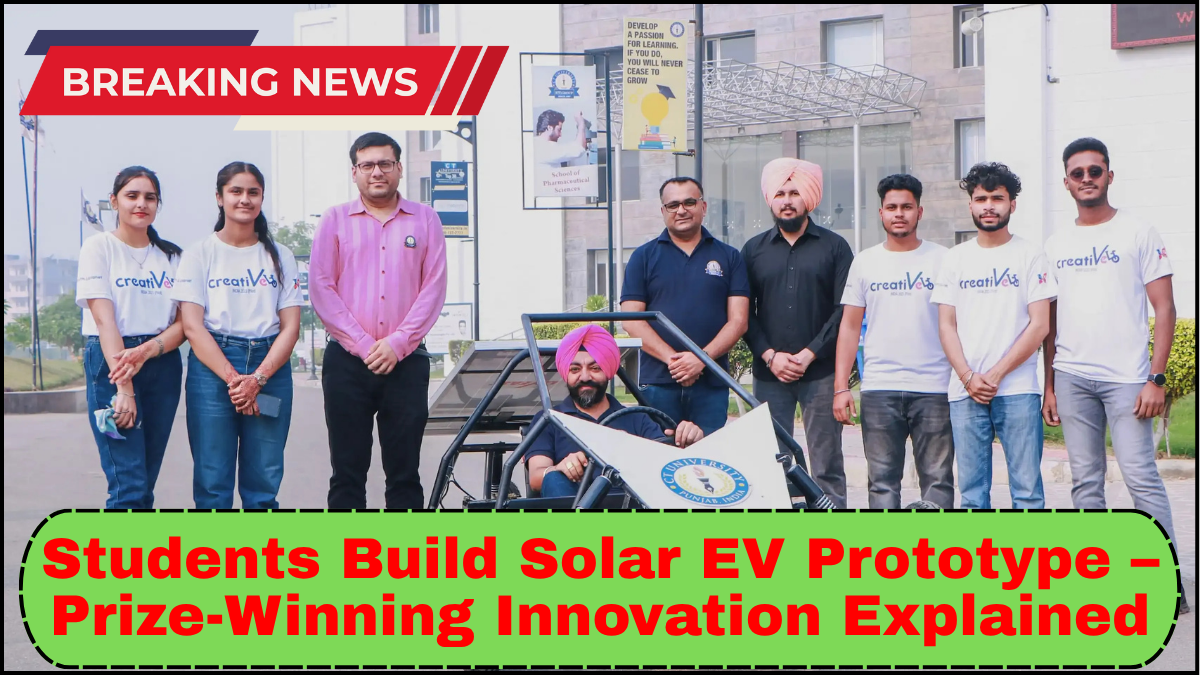Student innovation in AutoTech is no longer limited to classroom theory. A group of engineering students from a leading university has proven just how far ambition and technical skill can go. Their solar-powered electric vehicle (EV) prototype didn’t just turn heads—it won a national award for sustainability and engineering excellence.
This groundbreaking campus project showcases not only technical ingenuity but also the rising potential of student-led innovation in the rapidly evolving field of green transportation.

The Idea Behind the Innovation
The team’s concept was born out of a shared frustration: the environmental impact of fossil fuels and the lack of affordable green transportation solutions, especially in developing regions. What began as a brainstorming session quickly turned into a year-long commitment to build a fully functional solar EV prototype that could pave the way for future low-cost, sustainable vehicles.
Rather than just focusing on style or speed, the students emphasized real-world utility, efficiency, and ecological value. Their goal was simple—create a vehicle that runs entirely on solar energy, is affordable to build, and viable for urban and semi-urban environments.
Building the Prototype: Engineering Meets Ingenuity
What set this campus project apart from typical student efforts was the professional-level execution. The team used lightweight composite materials to build a sleek, aerodynamic frame. The car was equipped with high-efficiency monocrystalline solar panels integrated into its roof and hood, which charged a lithium-ion battery pack powering a compact electric motor.
Key technical highlights include:
-
Custom Battery Management System (BMS): Designed in-house to monitor voltage, temperature, and current flow for optimal battery performance and safety.
-
Regenerative Braking System: Captures kinetic energy during braking and converts it back into stored electrical power.
-
Real-Time Energy Dashboard: A custom-developed interface displays solar input, energy consumption, and route efficiency.
Despite budget constraints, the team sourced many components from recycled electronics and partnered with local startups for 3D printing and fabrication.
Winning the Prize: Recognition of Future-Focused Engineering
Their hard work paid off. At the National AutoTech Innovation Challenge, the team outperformed over 70 other entries, securing the top prize for Best Sustainable Vehicle Prototype. Judges praised the project for its scalability, efficiency, and real-world impact.
What made this student innovation exceptional was not just the tech, but the fact that it addressed broader environmental and social challenges—accessibility, affordability, and sustainability.
Student Innovation in AutoTech: Why It Matters
AutoTech is evolving at breakneck speed, and students are no longer just spectators—they’re active contributors. This solar EV prototype is a prime example of how campus projects can break out of academic silos and influence the real-world automotive sector.
The project also highlights an important shift in engineering education: hands-on problem-solving, interdisciplinary collaboration, and socially conscious design are now at the heart of modern curricula.
The Bigger Picture: Toward Scalable Green Mobility
This student-built solar EV isn’t just a one-off prototype. The team is now working with industry mentors to refine the model and explore mass production potential. With additional investment, the vehicle could be deployed as a last-mile transport solution in rural areas or as a zero-emission option in urban delivery fleets.
The success of this innovation illustrates how campus projects can lead to marketable technologies. It also reinforces the value of student innovation in tackling large-scale global challenges—climate change, urban pollution, and energy access.
FAQs
Q1: What makes this solar EV different from commercial electric vehicles?
A: Unlike most commercial EVs, this student prototype runs entirely on solar energy without relying on grid-based charging. It also emphasizes affordability and design simplicity to make it accessible for broader use.
Q2: How much did it cost to build the prototype?
A: The team built the vehicle on a modest budget of under $5,000 by using recycled materials and leveraging local partnerships.
Q3: Can this prototype be commercialized?
A: Yes. The team is now refining the design and seeking investment for scalability. The vehicle has potential in low-speed urban and rural transport applications.
Q4: How long does the vehicle run on a single solar charge?
A: Under optimal sunlight conditions, the solar panels generate enough energy for approximately 60–80 km of range per day.
Q5: What skills did students gain from this project?
A: Apart from technical skills in electronics, fabrication, and automotive design, students gained experience in teamwork, project management, and sustainable engineering practices.
click here to learn more